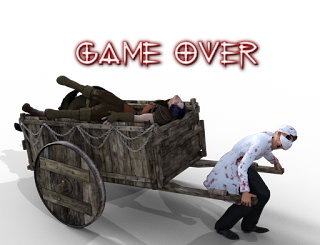An accompanying demo is available with this tutorial.
This is how to create a basic woodcutting process in RM2K3, similar to that used in
Runescape, but without the experience points gained.
Using the "defaults" from a new Project, first create two common items:
Handaxe and
Logs.
Also, create a variable to store the number of logs chopped. In this example,
0001:Wood.
Next, create a map and place a few events on it, setting the event graphics to trees. Make sure you name each one differently, as each one also has a matching switch. For this tutorial, I created 4 "tree events", named
Tree1,
Tree2,
Tree3 and
Tree4.
Create another event for the Woodcutter, who will give you an axe with which to chop the trees down. In the Woodcutter's Event Commands, we'll need to set it up so that:
- He first checks to see if you have a Handaxe. If not, he'll give you one. If so, he'll tell you how many logs you've chopped.
- If you've collected the required number of logs (in this case 10), he'll congratulate you. If not, continue until you have the number of logs.
The code for this is as follows:
The next step is to set up the trees so that they can be chopped down and you'll receive some logs. We'll start with the "Tree1" event.
Create 2 pages. In the Event Commands (Page 1), we need to:
- Check once more if you have a Handaxe - you can't chop trees down with your bare hands, after all.
- If not, display an appropriate message.
- If so, change the tree to a stump and add the logs to the inventory, not forgetting to "store" the number of logs possessed.
- Finally, add some sound effects and chop away!
On Page 2, set the first switch under "Preconditions" to
0001:Tree1 and the "Event Graphic" to that of a tree stump.
Repeat the steps for the other tree events, changing the name of the switch to match the name of the event, i.e. in event
Tree2 the switch name would be
Tree2, and so on.
Now, of course, since we only created four trees, but need 10 logs for the tutorial, the trees would need to regrow. For this, we need to create a simple variable-based timer. Set the "Trigger Condition" (on Page 2) to "Parallel Process". In the Event Commands, place the following:
Repeat for the other Tree events, once again changing the Switch Operation to the corresponding event name.
When you've collected 10 logs, speak to the Woodcutter and demo over.
 I originally wrote this script for RMXP, although adapted to RMVX (both scripts are available below).
I originally wrote this script for RMXP, although adapted to RMVX (both scripts are available below).

 >
>










































